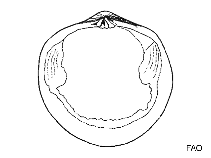Felaniella sowerbyi Kuroda & Habe, 1952
Google image | No image available for this species;
drawing shows typical species in Ungulinidae.
Classification / Names Common names | Synonyms | CoL | ITIS | WoRMS
Bivalvia | Venerida | Ungulinidae
Environment: milieu / climate zone / depth range / distribution range Ecology
Benthic; depth range ? - 33 m (Ref. 75840). Subtropical
Distribution Countries | FAO areas | Ecosystems | Occurrences | Introductions
Northwest Pacific: China, Taiwan, Japan and Hong Kong.
Length at first maturity / Size / Weight / Age
Maturity: Lm ? range ? - ? cm
Life cycle and mating behavior Maturity | Reproduction | Spawning | Eggs | Fecundity | Larvae
Main reference
References | Coordinator | Collaborators
Kuroda, T. and T. Habe 1952 Checklist and bibliography of the recent marine Mollusca of Japan. Leo. W. Stach, Publisher, Tokyo. 210 pp. (Ref. 77663)
IUCN Red List Status
(Ref. 130435: Version 2025-1)
CITES status (Ref. 108899)
CMS (Ref. 116361)
Threat to humans
Human uses
| FishSource |
Tools
More information
Diet composition
Food consumption
Predators
Max. ages / sizes
Length-weight rel.
Length-length rel.
Length-frequencies
Mass conversion
Abundance
Internet sources
BHL | BOLD Systems | CISTI | DiscoverLife | FAO(Publication : search) | Fishipedia | GenBank (genome, nucleotide) | GloBI | Gomexsi | Google Books | Google Scholar | Google | PubMed | Tree of Life | Wikipedia (Go, Search) | Zoological Record



